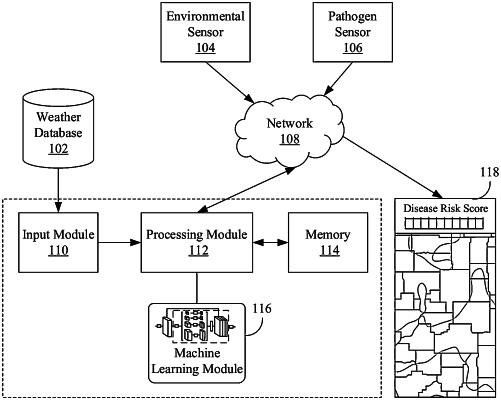| CPC A01B 79/005 (2013.01) [G01W 1/02 (2013.01); G06N 3/0442 (2023.01)] | 5 Claims |

|
1. A non-transitory physical storage medium storing program code, the program code when executed by a hardware processor executes a process for predicting an airborne disease related to a crop field of a crop and neighboring crop fields, the program code comprising steps to:
receive a sample historical weather data set from a weather information service;
receive a sample known disease risk indicator set associated with the airborne disease, wherein at least one sample known disease risk indicator set originates from ground-truth severity measures of the airborne disease through measurements of canopy conditions;
cross-validate the sample historical weather data set by applying leave-one-out cross-validation on a plurality of crop fields observed in the at least one sample historical weather data set (leave-one-field-out);
execute neural network training of a disease risk machine learning module on ground truth data comprising the cross-validated sample historical weather data sets from the weather information database and the one or more sample known disease risk indicator sets associated with the airborne disease, wherein the disease risk machine learning module is a bidirectional long short-term memory (LSTM) neural network;
receive an ambient weather parameter related to environmental conditions within or surrounding the crop field from an environmental sensor;
execute the disease risk machine learning module to determine a predicted disease risk indicator associated with the airborne disease and the crop field based on the ambient weather parameter;
measure a pathogen incidence indicator related to a presence of a pathogen within or surrounding the crop field using a spore collection device located within a distance threshold to the crop field, wherein the pathogen is associated with the airborne disease, and wherein the spore collection device is a hardware device that detects the number of pathogen spore particles per unit volume;
generate a disease score based on combining the predicted disease risk indicator and the pathogen incidence indicator, wherein the disease score represents a predicted severity of the airborne disease within the crop field; and
generate a disease heat map for the airborne disease over the crop field and the neighboring crop fields, wherein the disease heat map is generated from the disease score over the crop field and disease scores over the neighboring crop fields.
|